For far too many years, I did not know the difference between the various kinds of sleeves, to my sorrow. Because different kinds of sleeves will look very, very different on a human body. I had this vague dissatisfaction about some of my sweaters and shirts; I knew they didn't fit the way I wanted them to but I didn't know why. On the other hand, I had sweaters and shirts that I loved and wanted to wear all the time. Intuitively, I knew they fit me better and were more flattering, but again, I just couldn't put my finger on why.
After I began knitting, and reading extensively about knitting, I discovered that one very significant factor in whether I would love a sweater or not want to wear it much was the structure of the sleeves. So here is part I of the Official Go Knit In Your Hat Sleeve Tutorial. (More parts will come as I write them. Be patient; I scanned and loaded a buttload of photos for your edification.)
Let's start with drop sleeves. Here's a schematic of a sweater (I know you can read schematics, because we talked about them eons ago, right?):

This is the most basic sweater one could possibly design or make: it's a bunch of rectangles. Rectangle for the front, rectangle for the back, even the sleeves are rectangles. It's easy to make because you don't have to do any increasing or decreasing; you just knit rectangles. It's easy to design because you don't have to plan any increasing or decreasing, and if you are going to use some kind of pattern stitch, or stranded design, or cables (and I hope to God you are, or it's gonna be one boring damn sweater), you don't have to worry about increases or decreases or pesky sleeve openings cutting into the pattern. Note that I've marked the place where the sleeves are sewn to the body with blue lines and labeled them "seam lines."
This is a slight variation on the Rectangle sweater: it's the Modified Rectangle model. Still uses rectangles for front and back, but the sleeves are now trapezoids (they start narrower and increase as they go up).
What is most important about either of these sweaters for our purposes is the place where the sleeves meet the front and back. In both versions, there is no shaping, no cutting in for where the sleeve meets the front and back. You can see the sleeve top is a straight line and it's sewn in a straight line to the straight edge of the front and back.
And that's the problem.
Women's shoulders look like this.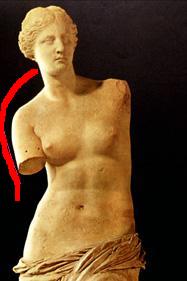
They slope downward and are curved. Their arms continue this sloping line.
When you put a drop shoulder on a woman, you are trying to superimpose a boxy rectangle on a sloping, curvy form.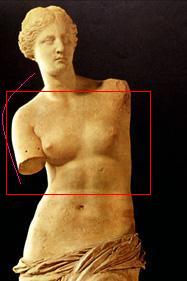
It doesn't match. And that is why you end up with all kinds of extra fabric pooching out in all the wrong places.
Let me give you some examples.
This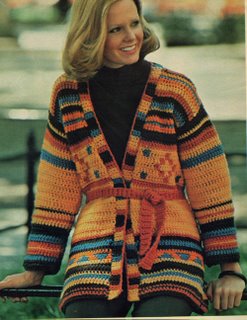
is an abomination from my collection of vintage patterns (meaning all the old magazines and crap stuffed in the office upstairs). Now I've marked it up a little:
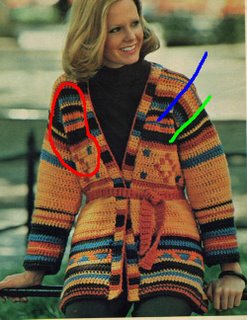
The green line shows where the seam line is, i.e., where the sleeves are sewn to the body of the jacket. The blue line shows about where the model's natural shoulders are. See where that seam line falls? See how it drops off the model's natural shoulder line? That's the Dreaded Drop Shoulder. From a fashion standpoint -- and more important for us, a fit standpoint, the Drop Shoulder is the Seventh Sign of the Apocalypse. It is Evil. It is Unattractive. Very few women look good in a drop shoulder sweater.
You can see why pretty easily: the sweater doesn't follow the natural curve of the woman's shoulder. It sags and there's unnecessary knitted fabric that hits in all the wrong places (some of which is shown in the red circle). Yet for as unattractively as they fit most women (and I'm sure there are exceptions to this rule, which smug commenters will promptly tell me about) drop shoulder sweaters are ubiquitous. You can't open a Dale of Norway pattern book without getting hit over the head with them: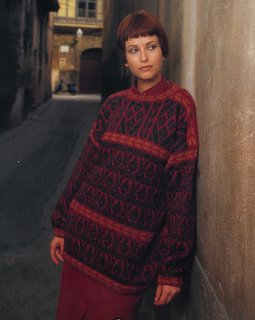
Lovely patterning, no? But it looks sack-like on the (almost certainly very slender) model: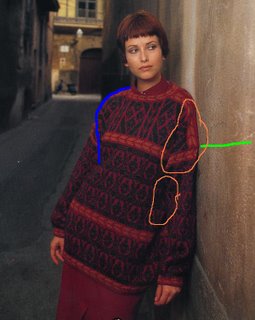
There's the seam line, shown in green. The natural line of the model's body is shown in blue, and the circles show some of the extra fabric that contributes to the burlap sack look. Don't get me wrong: I love Dale of Norway. But for as exquisite as the stranded knitting and colorwork and ethnic designs of traditional Dale sweaters are, many of them, oh so many of them, have those poky, saggy drop shoulders.*
Here's one from Rowan:

Marked-up:

The alternative to drop shoulders are set-in sleeves. Set-in sleeves are a little harder to make, and harder to design, but they are infinitely more flattering to wear. If you were dissatisfied with your last sweater project because of the way it fit, and it had drop shoulders, don't give up on making sweaters yet. Try a sweater with set-in sleeves.
Set-in sleeves are sleeves which are "set in" to the body of the sweater. When you are knitting the front and back, to get to the place where you want the armhole to start, and you bind off stitches in each side, like so:

You may bind off a few stitches or a lot, and you will probably continue to do some decreases as you continue the body of the sweater to get rid of that extra fabric that you don't need there. When you knit the sleeves, you will make a similar line of bound-off stitches and possibly decreases, in order to create an edge that mirrors the lines of the front and back. You want the edge of the sleeve to mirror the armhole of the front and back so that you can match those mirror edges and sew a seam.
Now look at some set-in sleeves from Rowan.
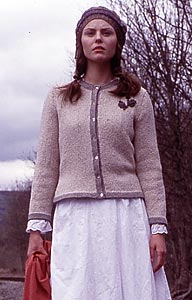
The marked-up version:
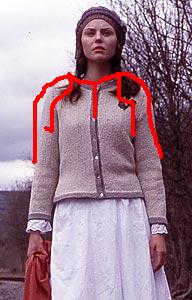
See how the sweater follows the natural line of the model's shoulders, shown in the top red line. See how the structure of the sweater, marked in the second red line, cuts in for the sleeves, eliminating the extra fabric. And see how much neater, less sloppy, more trim and well-fitting it looks?
Here's a denim jacket:
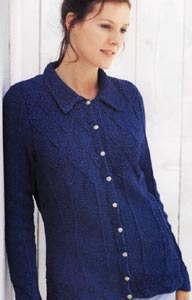
See the difference? Here's why:
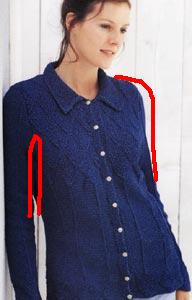
Again, the jacket follows the natural line of the model's shoulders (line on the right) and instead of having extra saggy, baggy fabric, it fits beautifully (look at the red line on the left, where you can see how the sweater nips in for the armhole and sleeve). What a difference.
If you learn nothing else from my blog but the difference between drop shoulders and set-in sleeves, I will be able to sleep well tonight.
*To be fair, in recent years, Dale has made an attempt to show more women's sweaters that have other kinds of sleeves.






18 comments:
Carol,
Thank you for this insightful tutorial. Like you say, sometimes it's hard to pin point or put into words what you know, intuitively, is wrong or right. This makes so much sense.
oh, yay! set-in sleeves is the kind I'm knitting for my sweater now but didn't know it! sleep well, my friend....sleep well!
Me, I don't think drop shoulders are always heinous.
Depends on the weight and spin of the yarn.
Leave it to you, my little pierogi, to show a hideous crocheted disaster to make your point.
Oh, and thans for sharing the always charming and engaging Grace and Nick today.
Hah! Now, you will notice that nowhere appears the word "crochet". It is simply called a vintage abomination. Remember, pet, I am one of your peeps who does not trash the cro-shay, but rather wishes I could do it as good as yin.
Nick and Grace bragged about having lunch with you to their brother AND their father. Both brother and father were jealous. As well they should be.
Whaddja buy?
Very informative and entertaining.
Sleeves scare the shizzit out of me, so I have not attempted a sweater. A rectangle seam I think I would be able to handle but a set in sleeve? Yoiks
Great tutorial,
I will be looking forward to more tom come, espcially about amny male/female variations. I would like to know if either of the sleeves described are better for men, or if men have the same should issues... or not...
My first sweater was a set-in sleeve. Wow, I learned so much about shaping and finishing. I wear it in public and I like it. (Ann Budd book)
Second sweater last year was a drop sleeve hoodie from stitch and bitch 2. I had no clue what I was doing. I just liked the casual look of it. When I went to measure sleeves to be sure I was making them long enough I forgot to account for the 'drop' so I added like two inches. Guess what! Now I have to roll them up. UGH. I debated ripping it back two inches. Still probably could. But sometimes I wear it outdoors and it doubles as mittens! And I don't usually wear that one in public. AND I'll never make a drop sleeve again. It's a sloppy look I think.
Thank you, Carol. I really appreciate the way you explain things!
Carol, thanks for the explanation of not only how dropped sleeves are constructed, but also why they're popular even though they can also look amazingly sloppy (a shoulder seam which rests at the apex of the bicep? ewwww). Could you please say a bit about saddle shoulders and/or Elizabeth Zimmerman's seamless yoke sweater, in which the sleeves are attached to the body of the sweater at the armpits and then the "shoulders" are worked in the round up toward the neckline? I'm contemplating trying a seamless yoke for my first sweater, but I have fairly wide shoulders and don't know how well it would fit or flatter.
I hope you extend this useful tutorial into menswear, because there are *so* many men's sweaters that have dropped shoulders, and they only look good on guys built like....olympic gymnasts i.e. guys with Shoulders.
Not having Shoulders myself, I am --of course-- looking at finishing up a sweater to take to Rhinebeck (should I get there) which has dropped shoulders.
Maybe I'll just burn it and start on something else.
BTW, do you think it says something about me that I've already selected the travel knitting for the trip to Rhinebeck, even though I don't know if I'm going?
You're going, Ted.
Even if Mar has to come get you.
Does it say something about me that I've probably already decided what to wear to Rhinebeck?
Well, yeah.
Awww Carol, I was so hoping for a picture of the hideous batwing sleeves from the 80's. Yeah, it took me way too long to discover that batwing sweaters didn't make booblets look bodacious.
Okay Kathy, but I expect you to be wearing something drop-dead gorgeous that you crocheted. Your reputation is preceding you.
Thanks for a great post...I am going to try and modify the sleeves/shoulders of some of the sweater patterns that I own so that they will be more flattering than the infamous "drop shoulders". Wish me luck! :-)
Blogless Mary Lou
Oy, Ted, such pressure...not sure that my garments will live up to your expectations or Caro's way flattering flattery.
I want a duscussion of the current boggling everpresent waist shaping.
"No waist shaping" seems to have become a dire insult.
Those of us with no waist to speak of (it's what becomes of the "cute boyish figure" when you leave your early 20's) don't look so gorgeous in the shaped=waist designs that are now ubiquitous.
great articel.
loved it.
Thanks for a little education with my morning coffee, Carol.
I'm scared to death of set-in sleeves, and it's why I've only knit one sweater (and ummm...it's a drop shoulder). Actually, it looks pretty damn good on me, but it's not trying to be something it is not. It's just a slightly oversized hoody. A classed up sweatshirt.
My next sweater is going to be a tank top (see? still living in set in sleave fear). And I think I could handle a raglan. Can't wait to read your next installation...empower me, baby ;-)
So...what say ye about the "modified drop" shoulder?
Post a Comment